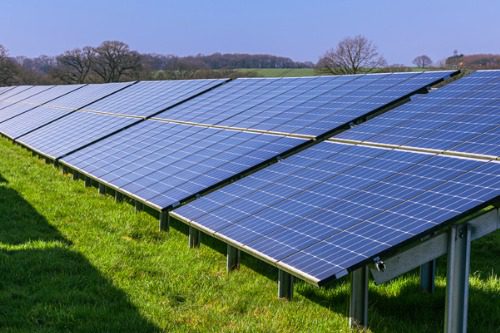A sustainable global economy – The road to transition

Authored by Vicky Roberts-Mills, Global Head of Energy Transition at AXA XL
The energy transition is integral to the drive towards a more sustainable global economy. Supporting the transition is a key part of our climate and sustainability strategy at AXA XL. Vicky Roberts-Mills, newly appointed global head of energy transition at AXA XL, discusses some of the opportunities for the insurance community to become a leader in, and driver of, a workable transition.
Ensuring a fair global energy transition requires investment in, and rebuilding of, infrastructure, and innovation in new technology and energy systems. It requires collaboration and knowledge-sharing, thinking outside of the box and being prepared to adapt – often quickly. Insurance is and will continue to be a fundamental enabler of the energy transition.
At a market-wide event in London in September, hosted by AXA XL and bringing together experts from across the energy industry, investment, insurance and academia, panelists acknowledged the enormous cross-industry effort required to make the transition happen. A huge re-allocation of capital will be needed to achieve what will, in the words of one of those panelists, be the most transformative shift since the first industrial revolution in the 18th century.
It’s estimated that about $130 trillion will be invested worldwide to help achieve the transition to net-zero carbon emissions by 2050. Insurance has a fundamental role to play in that process, as an investor, an enabler of innovation, a backer of construction and an underwriter of operations.
Indeed, members of the panel on ‘The New Energy System’ at the London event held in the autumn underscored the importance of the role of insurance, noting that insurance coverage is needed to give credibility to projects and to support innovation all the way along the line.
Achieving the energy transition will require finding a balance between energy security, energy equity and energy sustainability needs, specific to both regional geographies and wider geopolitical, macroeconomic and weather-related events. This means there are likely to be multiple energy transitions happening across the world. These transitions will take place in different ways and at different speeds.
AXA XL’s energy transition work begins, naturally, with the energy portfolio – but this is a drive that affects the entire economy. And to help enable this transition, there are, in effect, three pillars that our energy transition activities and ambitions must straddle; products and services; distribution; and capability and learning and development.
This energy transition strategy must be built and delivered in a client-centric way to ensure that the needs of our clients are both understood and met, across their portfolios and the life-cycle of their assets using both traditional and innovative solutions.
Rethinking products and services
To play our part in the energy transition, we need to deliver products and services that help our clients to meet their goals. Whether those clients be long-established energy companies moving from traditional methods of producing oil and gas into more sustainable and efficient processes, companies that have historically relied heavily on fossil fuels looking to move to alternative fuel sources, energy companies shifting some or all of their focus into renewable energy, or start-ups developing new technology.
AXA XL has been underwriting coverage for renewable energy projects, particularly solar, wind and hydro-electric operations, for some years now. And we are actively working with clients to provide coverage for a wide range of renewable energy technologies and operations, from windfarms to hydrogen production, to bioenergy to carbon capture underground storage (CCUS) and many others.
While some of these technologies might feel new, we already have enormous expertise that can be applied to assess, understand and underwrite them. For example, while CCUS is still in development, our upstream energy teams have vast experience of assessing and underwriting exploration projects therefore they have knowledge and experience that can be transferred.
Some renewable technologies, however, are prototypical in nature, and others are very much still in the developmental stages. In these instances, there are not large quantities of performance or loss data to review and on which to base underwriting decisions. Here we need to work with clients and brokers to gain as much understanding as we can about the opportunities and risks inherent in these developments and find ways to help assess, manage and transfer those risks.
We need to work – consistently and continually – to add to and improve our understanding of new technologies, including design and engineering, and to develop sustainable risk transfer solutions.
Some time ago, we created a series of best practice groups to enable construction and energy underwriters and engineers to share knowledge and work to understand some of these changes, to better be able to assess and – ultimately – offer insurance solutions for them.
These groups will form an agile, multi-disciplinary community – worldwide – that will foster collaboration and continuous learning. This will enable us to use this expertise, across regions, to adapt risk knowledge and transfer to both individual technology developments and complex, integrated energy projects.
Also, key to our strategy is bringing together the full capabilities of the AXA group to meet clients’ needs on the energy transition journey. There are numerous ways in which we can tap into the expertise from across the global group – whether that be AXA XL’s Structured Risk Solutions or Political Risk, Credit and Bond teams, or AXA Investment Managers’ fund solutions, and much more.
Emission-control planning
The energy transition, however, is not just about new technologies and innovation. Much of the transition is, and will continue to be, about assisting clients on their journey to reduce emissions. Insurance can also be an enabler in this process too.
We work hard to understand the emission control plans of those clients that can demonstrate to us they have a clear direction of travel in terms of making processes more efficient and cutting down on emitting activities.
There is a moral hazard to be considered here; it is vital – for our business plans, for our clients and for the economy overall – that clients are not left as stranded assets. For our underwriting portfolio to be diverse and sustainable, we need to work with clients as they make the transition to lower-emission models.
Industry evolution
A hugely important part of my role as global head of energy transition is to help our colleagues – current and future – to think differently about products and the way they make decisions. The energy industry is evolving, and our teams are evolving too.
That means looking to recruit diverse talent from a range of employment and educational backgrounds, and harnessing knowledge from the energy industry and other related sectors, to help gain a better understanding of, and different perspectives on, the risks and opportunities involved in the transition.
And we already have a huge bank of experience and expertise about how to underwrite so-called traditional energy risks. Working with our teams to adapt and apply that knowledge is an exciting opportunity for those colleagues too. AXA XL does not silo energy underwriting into separate ‘renewable’ or ‘traditional upstream’ buckets. Instead, colleagues work with clients across the spectrum.
Continuous learning and development opportunities will not only help our energy underwriters to help our clients, they will give those underwriters exciting opportunities to build and future-proof their own careers.
The onward journey
As the recent COP28 event underlined, an enormous global effort is required to get to where we want to be by 2050 and there is a definite need to pick up the pace.
Our clients are at different stages along the route to transition. The insurance market can help them on the journey. As our clients adapt, we must adapt too – in a sustainable way.
That means being there for those clients that can demonstrate robust carbon-emission-reduction plans. And it means being there for those clients that are innovating to find new ways of producing energy.
Heading into 2024, our clients will renew their efforts – no pun intended – to meet the emission-reduction and sustainability goals they have set for themselves and which their stakeholders expect of them. The insurance industry, by providing stable, viable and innovative capacity, will do the same.






